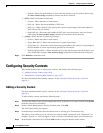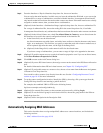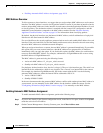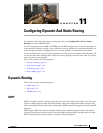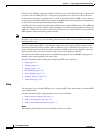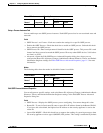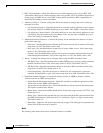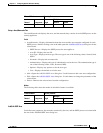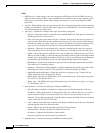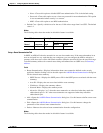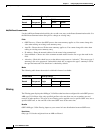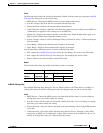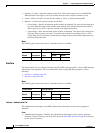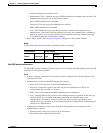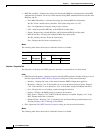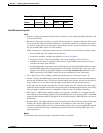
11-6
Cisco ASDM User Guide
OL-16647-01
Chapter 11 Configuring Dynamic And Static Routing
Dynamic Routing
Fields
• OSPF Process—When adding a new area, choose the OSPF process ID for the OSPF process for
which the area is being. If there is only one OSPF process enabled on the security appliance, then
that process is selected by default. When editing an existing area, you cannot change the OSPF
process ID.
• Area ID—When adding a new area, enter the area ID. You can specify the area ID as either a decimal
number or an IP address. Valid decimal values range from 0 to 4294967295. You cannot change the
area ID when editing an existing area.
• Area Type—Contains the settings for the type of area being configured.
–
Normal—Choose this option to make the area a standard OSPF area. This option is selected by
default when you first create an area.
–
Stub—Choosing this option makes the area a stub area. Stub areas do not have any routers or
areas beyond it. Stub areas prevent AS External LSAs (type 5 LSAs) from being flooded into
the stub area. When you create a stub area, you have the option of preventing summary LSAs
(type 3 and 4) from being flooded into the area by unchecking the Summary check box.
–
Summary—When the area being defined is a stub area, unchecking this check box prevents
LSAs from being sent into the stub area. This check box is selected by default for stub areas.
–
NSSA—Choose this option to make the area a not-so-stubby area. NSSAs accept type 7 LSAs.
When you create a NSSA, you have the option of preventing summary LSAs from being flooded
into the area by unchecking the Summary check box. You can also disable route redistribution
by unchecking the Redistribute check box and enabling Default Information Originate.
–
Redistribute—Uncheck this check box to prevent routes from being imported into the NSSA.
This check box is selected by default.
–
Summary—When the area being defined is a NSSA, unchecking this check box prevents LSAs
from being sent into the stub area. This check box is selected by default for NSSAs.
–
Default Information Originate—Check this check box to generate a type 7 default into the
NSSA. This check box is unchecked by default.
–
Metric Value—Specifies the OSPF metric value for the default route. Valid values range from
0 to 16777214. The default value is 1.
–
Metric Type—The OSPF metric type for the default route. The choices are 1 (type 1) or 2 (type
2). The default value is 2.
• Area Networks—Contains the settings for defining an OSPF area.
–
Enter IP Address and Mask—Contains the settings used to define the networks in the area.
IP Address—Enter the IP address of the network or host to be added to the area. Use 0.0.0.0
with a netmask of 0.0.0.0 to create the default area. You can only use 0.0.0.0 in one area.
Netmask—Choose the network mask for the IP address or host to be added to the area. If adding
a host, choose the 255.255.255.255 mask.
–
Add—Adds the network defined in the Enter IP Address and Mask area to the area. The added
network appears in the Area Networks table.
–
Delete—Deletes the selected network from the Area Networks table.
–
Area Networks—Displays the networks defined for the area.
IP Address—Displays the IP address of the network.
Netmask—Displays the network mask for the network.
• Authentication—Contains the settings for OSPF area authentication.



